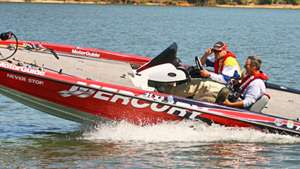
Playing to your angling strengths when the prevailing conditions all line up can pay off handsomely, as was apparent with Mike McClelland's win at the Bassmaster Elite Series held on Clarks Hill Lake. After four days of fishing the Arkansas pro mastered the Georgia fishery with his go-to bait, weighing an impressive 70 pounds, 7 ounces of largemouth caught on a jig.
For the second time in as many seasons, the talented Arkansas pro also underscored his talents as a jig fishermen after winning the Elite Series contest last summer on Oklahoma's Grand Lake.
At Clarks Hill, McClelland targeted mainlake points, those tapering fingers of shoreline that provide a year-round haven for largemouth. Points are undeniably the most abundant and noticeable features on highland and lowland reservoirs, which begs the question that McClelland found the answer to on Clarks Hill.
And that question is how do you sort through the hundreds of points on a given lake to find the best success?
Food and Shelter
McClelland camped out on the same point for the duration of the tournament, a wise move considering he was targeting postspawn largemouth.
"Largemouth will relate to mainlake or secondary points for the entire spawning cycle," he observes. "They use points as a place of rest during their migration between deep and shallow water. Points also provide the fish a combination of deep and shallow water they need during spring when the weather can be unpredictable."
And, as McClelland already knew, the structure provides largemouth with an ambush point for feeding on baitfish and in his case, the blueback herring that are the predominant forage on Clarks Hill Lake.
To the Point
Flats, structure and depth are the three words that answer the question about which points are the best to target on a given fishery.
"Points with flats are by far the best points in postspawn," says McClelland. "Secondly, it's key for the flat to have some type of isolated structure such as rock, brushpiles and stumps."
He continues, "a point with access to deep water nearby is the final key. The fish will relate to this scenario year-round since they have deep water, food, and even a place to spawn on the flat."
At Clarks Hill, the point chosen by McClelland was a final transition area for largemouth migrating from a spawning tributary back to the deeper mainlake. The outflow of fish funneling from the tributary replenished daily, giving McClelland a dependable supply of bass to keep him in contention for the win.
Practice Makes Perfect
"A lot of guys like to spend time fishing specific areas to test them out and eliminate water," observes McClelland. "I like to cover a lot of water, ride around and locate areas where I know the fish will be relating to, like the points with flats, deep water and isolated structure."
That said, McClelland spends his time testing the water with his jig to pinpoint specific sweet spots on a given point.
"I'll use a heavy jig, make long casts and drag it across a point," he says of his search bait. "I'm not so much interested in catching the fish as I am locating those isolated pieces of structure."
Boat Positioning
The give-and-take between boat positioning and casting targets is a key to summing up the equation for properly fishing a point, says McClelland.
"I fish into the wind because it eliminates any issues with boat control," he says. "You have better control of the boat using the trolling motor into the wind."





